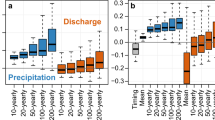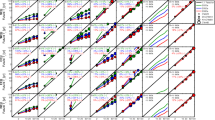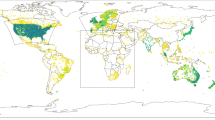Abstract
Extreme weather and climatic events can have detrimental effects on society. The coincidence of several factors, themselves not necessarily extreme, can have similar adverse implications, such as a combination of high spring-time temperatures and heavy rainfall. A combination of high temperature and heavy precipitation during spring can produce flooding when run-off due to snow-melt adds to river discharge from the rainfall. Such combined events are often referred to as ‘complex extremes’ (IPCC, Climate change 2001: impact, adaptation and vulnerability. Summary for policymakers. WMO, Geneva, Switzerland, p. 7, 2001) . A likely effect of a climate change is a shift in the frequency of both extremes in traditional sense as well as in complex extreme events. Results from a global climate model were downscaled through a higher-resolution nested regional climate model in order to obtain more realistic descriptions of regional climatic features in Norway. Empirically-based joint frequency distributions (two dimensional histograms) were used to study shifts in the frequency of complex extremes. A slight shift in the joint frequency distributions for spring-time temperature-and-rainfall was detected in downscaled results with HIRHAM from a transient integration with the ECHAM4/OPYC3 climate model following the IS92a emission scenario. The analysis involved values that spanned between ordinary and extreme values of the bivariate distributions complicating the estimation of a representative confidence interval as the data fall in the zone between different types of behaviour. The results from HIRHAM were spatially interpolated and compared with station observations, and substantial biases were revealed, however, the apparent model discrepancy is largely due to great small-scale variability due to a complex physiography. The general temporal trends predicted by the model are nevertheless realistic.
Similar content being viewed by others
References
Benestad RE (2001) The cause of warming over Norway in the ECHAM4/OPYC3 GHG integration. Int J Climatol 21:371–387
Benestad RE (2003a) How often can we expect a record-event?. Clim Res 25:3–13
Benestad RE (2003b) What can present climate models tell us about climate change?. Clim Change 59:311–332
Benestad RE, Hanssen-Bauer I (2003) Empirical-based refinement of dynamically downscaled temperature scenarios in southern Norway. KLIMA 07/03. The Norwegian Meteorological Institute, P.O. Box 43 Blindern, 0313 Oslo, Norway (www.met.no)
Benestad RE (2004) Record-values, non-stationarity tests and extreme value distributions. Glob Planet Change 44:11–26, doi:10.1016/j.gloplacha.2004.06.002
Benestad RE, Achberger C, Fernandez E (2005) Empirical-statistical downscaling of distribution functions for daily precipitation, Climate 12/2005. The Norwegian Meteorological Institute, P.O. Box 43 Blindern, 0313 Oslo, Norway (www.met.no)
Christensen JH, Christensen OB, Lopez P, van Meijgaard E, Botzet M (1996) The HIRHAM4 regional atmospheric climate model. DMI Sci. Rep. No. 96-4. Danish Meteorological Institute, Lyngbyvei 100, DK-2100 Copenhagen
Coles SG (2001) An introduction to statistical modeling of extreme values. Springer, London, UK
Dankers R, Christensen OB (2005) Climate change impact on snow coverage, evaporation and river discharge in the sub-arctic tana basin, Northern Fennoscandia. Clim Change 69:367–392
Easterling DR, Meehl GA, Parmesan C, Changnon SA, Karl TR, Mearns LO (2000) Climate extremes: observations, modeling, and impacts. Science 289: 2068–2074
Ellner SP (2001) Review of R, Version 1.1.1. Bull Ecol Soc Am 82:127–128
Frei C, Schär C (2001) Detection of trends in rare events: theory and application to heavy precipitation in the Alpine region. J Climate 14:1568–1584
Frich P, Alexander LV, Della-Marta P, Gleason B, Haylock M, Tank AMG, Klein, Peterson T (2002) Observed coherent changes in climatic extremes during the second half of the twentieth century. Clim Res 19:193–212
Gentleman R, Ihaka R (2000) Lexical scope and statistical computing. J Comput Graph Stat 9: 491–508
Gordon C, Cooper C, Senior CA, Banks H, Gregory JM, Johns TC, Mitchell JFB, Wood RA (2000) The simulation of SST, sea ice extents and ocean heat transports in a version of the Hadley Centre coupled model without flux adjustments. Clim Dyn 16:147–168
Hanssen-Bauer I, Førland EJ, Haugen JE, Tveito OE (2003) Temperature and precipitation scenarios for Norway: comparison of results from dynamical and empirical downscaling. Clim Res 25:15–27
Hayhoe K, Cayan D, Field CB, Frumhoff PC, Maurer EP, Miller NL, Moser SC, Schneider SH, Cahill KN, Cleland EE, Dale L, Drapek R, Hanemann RM, Kalkstein LS, Lenihan J, Lunch CK, Neilson RP, Sheridan SC, Verville JH (2004) Emission pathways, climate change, and impacts on California. Proceedings of the National Academy of Sciences, vol 101, pp 12422–12427. National Academy of Science, Washinton, DC
Hegerl GC, Zwiers FW, Stott PA, Kharin VV (2004) Detectability of anthropogenic changes in annual temperature and precipitation extremes. J Climate 17:3683–3699
Houghton JT et al (2001) Climate change 2001: the scientific basis. International Panel on Climate Change. WMO, Geneva, Switzerland (www.ipcc.ch)
Imbert A (2003) The analog method applied to downscaling of climate scenarios. KLIMA 08/03. met.no, P.O. Box 43 Blindern, 0313 Oslo, Norway (www.met.no)
IPCC (2001) Climate change 2001: impact, adaptation and vulnerability. Summary for policymakers. WMO, Geneva, Switzerland
IPCC (2002) Changes in extreme weather and climate events. Beijing, China http://www.ipcc.ch/pub/support/, (11–13 June)
López-Díaz J (2003) A nonparametric test for trends in the occurrence of rare events. J Climate 16:2602–2614
Meehl GA, Tebaldi C (2004) More intense, more frequent, and longer lasting heat waves in the 21st century. Science 305:994–997
Murphy J (1999) An evaluation of statistical and dynamical techniques for downscaling local climate. J Climate 12:2256–2284
Oberhuber JM (1993) Simulation of the Atlantic circulation with a coupled sea ice-mixed layer isopycnal general circulation model. Part 1: model description. J Phys Oceanogr 22:808–829.
Palmer TN, Räisänen J (2002) Quantifying the risk of extreme seasonal precipitation events in a changing climate. Nature 415:512–514
Roeckner E, Arpe K, Bengtsson L, Dümenil L, Esch M, Kirk E, Lunkeit F, Ponater M, Rockel B, Sausen B, Schlese U, Schubert S, Windelband M (1992) Simulation of present-day climate with the ECHAM model: impact of model physics and resolution. Tech. rept. 93. Max Planck-Institute für Meteorologie, Hamburg
Schubert S (1998) Downscaling local extreme temperature change in south-eastern Australia from the CSIRO MARK2 GCM. Int J Climatol 18:1419–1438
Senior CA, Jones RG, Lowe JA, Durman CF, Hudson D (2002) Prediction of extreme precipitation and sea-level rise under climate change. Philos Trans R Soc Lond A 360:1301–1311
Skaugen TE, Hanssen-Bauer I, Førland EJ (2002) Adjustment of dynamically downscaled temperature and precipitation data in Norway. KLIMA 20/02. The Norwegian Meteorological Institute, PO Box 43 Blindern, 0313 Oslo, Norway (www.met.no)
Schmidli J, Frei C (2005) Trends of heavy precipitation and wet and dry spells in Switzerland during the 20th century. Int J Climatol 25:753–771
von Storch H (1999) On the use of “inflation” in statistical downscaling. J Climate 12:3505–3506
Washington WM, Weatherly JW, Meehl GA, Semtner AJ, Bettge TW, Graig AP, Strand WG, Arblaster J, Wayland VB, James R, Zhang Y (2000) Parallel climate model (PCM) control and 1% per year CO2 simulations with a 2/3 degree ocean model and a 27 km dynamical sea ice model. Clim Dyn 16:755–774
Wilks DS (1995) Statistical methods in the atmospheric sciences. Academic, Orlando, FL
Wood AW, Leung LR, Sridhar V, Lettenmaier DP (2004) Hydrologic implications of dynamical and statistical approaches to downscaling climate model outputs. Clim Change 62:189–216
Yue S (1999) The Gumbel mixed model for flood frequency ananlysis. J Hydrol 226:88–100
Yue S (2001) Comment on Bivariate extreme value distributions: an application of the Gibbs sampler to the ananlysis of floods. In: Adamson PT, Metcalfe AV, Parmentier B (eds) Water Resources Research, vol 37, pp 1107–1110
Yue S, Rasmussen P (2002) Bivariate frequency analysis: discussion of some useful concepts in hydrological application. Hydrol Process 16:2881–2898
Author information
Authors and Affiliations
Corresponding author
Rights and permissions
About this article
Cite this article
Benestad, R.E., Haugen, J.E. On complex extremes: flood hazards and combined high spring-time precipitation and temperature in Norway. Climatic Change 85, 381–406 (2007). https://doi.org/10.1007/s10584-007-9263-2
Received:
Accepted:
Published:
Issue Date:
DOI: https://doi.org/10.1007/s10584-007-9263-2




